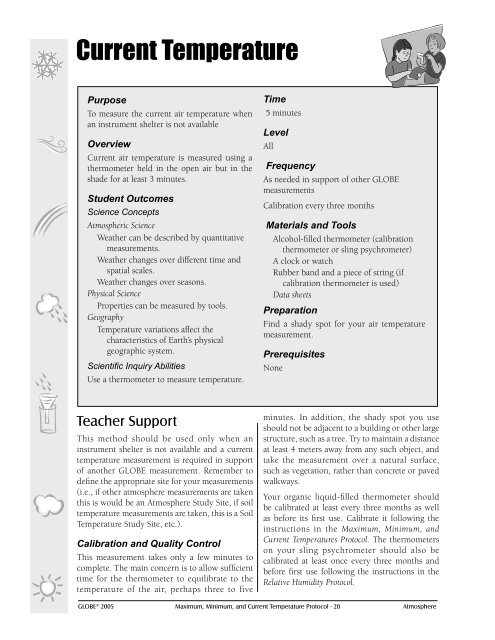Maximum, Minimum, and Current Temperature Protocol - GLOBE
Maximum, Minimum, and Current Temperature Protocol - GLOBE
Maximum, Minimum, and Current Temperature Protocol - GLOBE
You also want an ePaper? Increase the reach of your titles
YUMPU automatically turns print PDFs into web optimized ePapers that Google loves.
<strong>Current</strong> <strong>Temperature</strong><br />
Purpose<br />
To measure the current air temperature when<br />
an instrument shelter is not available<br />
Overview<br />
<strong>Current</strong> air temperature is measured using a<br />
thermometer held in the open air but in the<br />
shade for at least 3 minutes.<br />
Student Outcomes<br />
Science Concepts<br />
Atmospheric Science<br />
Weather can be described by quantitative<br />
measurements.<br />
Weather changes over different time <strong>and</strong><br />
spatial scales.<br />
Weather changes over seasons.<br />
Physical Science<br />
Properties can be measured by tools.<br />
Geography<br />
<strong>Temperature</strong> variations affect the<br />
characteristics of Earth’s physical<br />
geographic system.<br />
Scientific Inquiry Abilities<br />
Use a thermometer to measure temperature.<br />
Teacher Support<br />
This method should be used only when an<br />
instrument shelter is not available <strong>and</strong> a current<br />
temperature measurement is required in support<br />
of another <strong>GLOBE</strong> measurement. Remember to<br />
define the appropriate site for your measurements<br />
(i.e., if other atmosphere measurements are taken<br />
this is would be an Atmosphere Study Site, if soil<br />
temperature measurements are taken, this is a Soil<br />
<strong>Temperature</strong> Study Site, etc.).<br />
Calibration <strong>and</strong> Quality Control<br />
This measurement takes only a few minutes to<br />
complete. The main concern is to allow sufficient<br />
time for the thermometer to equilibrate to the<br />
temperature of the air, perhaps three to five<br />
Time<br />
5 minutes<br />
Level<br />
<strong>GLOBE</strong> ® 2005 <strong>Maximum</strong>, <strong>Minimum</strong>, <strong>and</strong> <strong>Current</strong> <strong>Temperature</strong> <strong>Protocol</strong> - 20 Atmosphere<br />
All<br />
Frequency<br />
As needed in support of other <strong>GLOBE</strong><br />
measurements<br />
Calibration every three months<br />
Materials <strong>and</strong> Tools<br />
Alcohol-filled thermometer (calibration<br />
thermometer or sling psychrometer)<br />
A clock or watch<br />
Rubber b<strong>and</strong> <strong>and</strong> a piece of string (if<br />
calibration thermometer is used)<br />
Data sheets<br />
Preparation<br />
Find a shady spot for your air temperature<br />
measurement.<br />
Prerequisites<br />
None<br />
minutes. In addition, the shady spot you use<br />
should not be adjacent to a building or other large<br />
structure, such as a tree. Try to maintain a distance<br />
at least 4 meters away from any such object, <strong>and</strong><br />
take the measurement over a natural surface,<br />
such as vegetation, rather than concrete or paved<br />
walkways.<br />
Your organic liquid-filled thermometer should<br />
be calibrated at least every three months as well<br />
as before its first use. Calibrate it following the<br />
instructions in the <strong>Maximum</strong>, <strong>Minimum</strong>, <strong>and</strong><br />
<strong>Current</strong> <strong>Temperature</strong>s <strong>Protocol</strong>. The thermometers<br />
on your sling psychrometer should also be<br />
calibrated at least once every three months <strong>and</strong><br />
before first use following the instructions in the<br />
Relative Humidity <strong>Protocol</strong>.
















